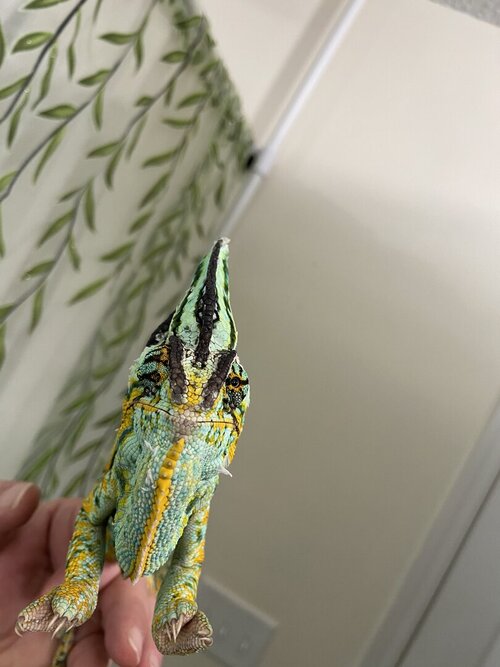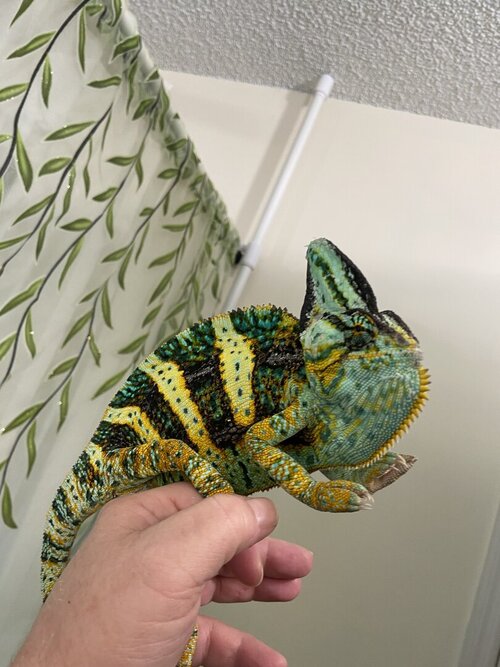Hello ! I recently made another thread and while I found the responses very very helpful I thought I would make another with all of this information filled out and with better, more specific questions.
- Currently I am most worried about his eating. The first feeding he was voracious, and I have simply not seen that attitude in the last couple of days. After seeing the urate today I was worried about dehydration as well but with the live plants there is just so so so much more room for water to drop on leaves now I think he will get the memo.
- I really just wanted to post with all information again to see if there are any glaring missteps in my care so far. I think I am heading in the right direction but all I care about is his health and happiness I want to make sure I am doing the best.
Just a note also regarding the pictures, I do not know why in every photo the light looks so blue? I really feel as if it does not look like that at ALL in real life but if that is a sign of something please let me know.
Thank you so much

This is him today!

This is a terrible photo of what the enclosure looks like after I moved everything around.

For example this is what it looked like before, I have now removed all substrate/paper towels from the bottom it is empty now


This is everything else I have going on.
- Your Chameleon- The species, sex, and age of your chameleon. How long has it been in your care?
- He is a male veiled chameleon that I would say is between 3-5 months old I do not know. (body+head is roughly 5 inches) I have had him for almost a week and a half now.
- Handling- How often do you handle your chameleon?
- I have only handled at the reptile expo and moving him into this new enclosure.
- Feeding- What are you feeding your cham? What amount? What is the schedule? How are you gut-loading your feeders?
- I am feeding him a mixture of crickets, dubias, and a few hornworms. So far I have been feeding him every single day, but other than the first day where he ate about 15 crickets I don't think he has eaten more than 4-5 crickets or dubias + 1 hornworm in a day. I have been trying to feed him as early in the morning as I can so he has time/heat to digest but I am worried about the last few days. He seems very excited for the first couple and then just seems to loose interest. So far I have been gut-loading with a bag of Lugarti cricket food that I bought just for ease of access these first few weeks but want to switch purely to greens.
- Supplements- What brand and type of calcium and vitamin products are you dusting your feeders with and what is the schedule?
- The last 4 days I have been dusting with zoo med repti calcium without D3 every day.
- Watering- What kind of watering technique do you use? How often and how long to you mist? Do you see your chameleon drinking?
- I have been hand misting between 3 and 5 times a day. I have been making sure once before bed and right after I wake up, and have been doing a few throughout the day to make sure he is hydrated. I have been misting for around 30 seconds each time, I am mainly trying to make sure there are water droplets on all of the leaves. I try to mist longer and specifically try and not mist straight at him but he acts like I am spraying him with a fire hose I feel terrible. I have seen him drink multiple times, I switched up a lot of the cage today so I was trying to leave him a lone so I did not see it after the most recent rearrange.
- Fecal Description- Briefly note colors and consistency from recent droppings. Has this chameleon ever been tested for parasites?
- I have only seen two droppings so far, the first one looked great, very solid and dark brown with dry very white urate. The more recent was much more liquid and slightly brighter brown and the urate looked slightly more liquid as well with just a tint of orange. He has not been tested.
- History- Any previous information about your cham that might be useful to others when trying to help you.
- I purchased him at a reptile expo and he came with a much younger female chameleon, both housed in a very small very poor glass enclosure. I quickly moved both of them into this new screened enclosure but had both of them together for a few days before I could find somewhere to rehome the girl. Obviously they did not get along the best and I do not know if at all or how long they were housed together before. I was mistakenly assured that they would be fine together and fine in the enclosure and feel very bad about stressing them out in such poor conditions for the time I did. Since the separation he seems much less stressed then when I originally got him.
- Just today I completely reorganized and switched everything around in his cage. I was worried about doing to much to soon and stressing him out even more while he was still getting accustomed but decided it would be better to make sure the enclosure was better first. I had a lot of fake leaves and other vines and sticks, while providing hiding spots and water collection it felt like I was robbing him of greater health and enjoyment when I could easily fix everything. As of today I took everything out and the enclosure is now just sticks/branches for climbing and basking, two fake vines so that there is better maneuverability around and to keep things in place, one large ficus and one large dracea, a smaller for shrubby ficus that he has enjoyed eating, and one shoot of bamboo in the back that I got for free.
- Cage Type- Describe your cage (Glass, Screen, Combo?) What are the dimensions?
- Large reptibreeze full screen enclosure (18",18",36") I have one side facing most of my room/bed/desk covered with blanket for humidity and just so he cant see me while im doing homework/being lazy, and another 1.5 sides sort of covered in press and seal (seran rap?) to try and trap some humidity in. If I am up much later than when his lights turn off I have been putting a very thin flag I have over part of the front to try and reduce the lamp light.
- Lighting- What brand, model, and types of lighting are you using? What is your daily lighting schedule?
- I have a 22" reptisun 10.0 UVB in a biomed cover and a 75 watt heat flood in a deep dome light for basking from scales and tales that are both on from 9am to 9pm
- Temperature- What temp range have you created (cage floor to basking spot)? Lowest overnight temp? How do you measure these temps?
- I have one of the reptile control center things they sell at scales and tales that has 6 plugs, two heat sensors, and a humidity sensor. basking spot during the day is ambient 80-85 F and cage floor is between 65-70 normally. Just this week it started getting warm and our ac has been funky so they have shifted a little day to day but almost always within those ranges. I have a secondary ceramic heat bulb I have been turning on for just a few minutes, pointed mid level of the cage, if I notice much lower temperatures during the day. Night time temperatures have been 65-70 at the top and usually 50-60 at the bottom. watching today after switching all fake to live plants the bottom is 63 which is the highest I have seen so far. I have seen 51-53 sometimes at the bottom but never under 50.
- Humidity- What are your humidity levels? How are you creating and maintaining these levels? What do you use to measure humidity?
- I have been changing this a lot recently because of reading more and more different information, but day times between 30-50% (normally around 38-40), after misting I obviously jumps up to crazy numbers for around 5 minutes and then slowly decreases again. At night I have been trying to get as high as I can but have simply had no success maintaining anything above 50%. During the day it is purely misting and recently with the help of live plants, but at night I have not been misting and running a reptifogger overnight as soon as the daytime temps drop. Humidity is also measured through the control center.
- Plants- Are you using live plants? If so, what kind?
- I have a large ficus tree, larger dracea tree of some sort, small ficus shrub, and one stalk of bamboo. Up until today there were a lot of fake leaves but they are now all gone.
- Placement- Where is your cage located? Is it near any fans, air vents, or high traffic areas? At what height is the top of the cage relative to your room floor?
- It is in the corner of my bedroom in the basement, maybe 5 feet away from a ceiling vent that may or may not work. It is my bedroom and I am in college so I and roommates have been in and out, but I have been trying to limit interaction and he has been getting left a lone for as much as I can during the day. The cage is on a roughly foot and a half tall desk off of the floor.
- Location- Where are you geographically located?
- I am in northern colorful Colorado, US
- Currently I am most worried about his eating. The first feeding he was voracious, and I have simply not seen that attitude in the last couple of days. After seeing the urate today I was worried about dehydration as well but with the live plants there is just so so so much more room for water to drop on leaves now I think he will get the memo.
- I really just wanted to post with all information again to see if there are any glaring missteps in my care so far. I think I am heading in the right direction but all I care about is his health and happiness I want to make sure I am doing the best.
Just a note also regarding the pictures, I do not know why in every photo the light looks so blue? I really feel as if it does not look like that at ALL in real life but if that is a sign of something please let me know.
Thank you so much
This is him today!
This is a terrible photo of what the enclosure looks like after I moved everything around.
For example this is what it looked like before, I have now removed all substrate/paper towels from the bottom it is empty now
This is everything else I have going on.






